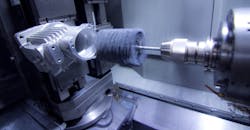Finish Machining is a Cost-Cutting Opportunity
Machine shops' labor concerns are typically involve training and experience, but new factors are presenting new problems: Whether it's the need to reduce labor costs due to declining work orders, or the scarcity of skilled operators, or the need to implement social-distancing guidelines, many shops are re-evaluating how to reduce their labor-intensive operations. Which manual operations can be effectively automated?
Atop this list must be the secondary finishing operations that are conducted offline to remove excess material on semi-finished parts. Much of this work is still performed by hand using oscillating tools, grinders, files, abrasive hand pads, and wire brushes.
Secondary operations like honing and polishing can be automated effectively using a variety of abrasive tools mounted in a toolholder and carousel without taking the part offline. Even better news is that in addition to reducing in-shop labor requirements, completing surface finishing simultaneously, in a single operation with machining, speeds production for high-volume parts.
“When the economy begins to recover in the coming months, machine shops are going to be driven to find ways to increase efficiency and one way is through automating offline processes,” according Tim Urano, quality manager at Wolfram Manufacturing, an Austin, Tex., shop that machines metal parts with complex geometries on four- and five-axis machines. “So, any time we can incorporate secondary operations right into the machining process, we save time, money, and also reduce our in-house labor requirements.”
According to Urano, Wolfram Manufacturing produces a range of complex parts with through-holes and so has automated the cross-hole deburring process. Removing burrs and sharp edges in cross-drilled holes and other difficult-to-access areas — such as undercuts, grooves, slots, or internal holes — is critical. Failing to remove burrs can cause blockages or create turbulence in the flow of fluids, lubricants and gases through critical passages.
To do this, the shop incorporates Flex-Hone tools in a variety of sizes in its tool carousels. The Flex-Hone, supplied by Los Angeles-based Brush Research Manufacturing (BRM), is characterized by the small, abrasive globules that are permanently mounted to flexible filaments. It's a flexible, low-cost tool for sophisticated surfacing, deburring, and edge-blending. The hones are available in a variety of abrasive types, sizes, and grit selections
Urano said Wolfram Mfg. has been installing Flex-Hone for eight years and uses them daily, usually several times an hour, on some of the shop’s highest volume parts. “On a given part, we might deploy two to three different size hones, depending on the number of cross-port intersections and different hole sizes,” he detailed. “It is very easy to put a Flex-Hone into a toolholder, give it a simple toolpath cycle, and let it run.
“Automating cross-hole deburring eliminates a lot of offline work,” Urano added. “The parts we make are complex and have a lot of intersecting holes, so relying on a person to repeat that process every single time, to the quality level required, always introduces some potential inconsistency. However, if we just let the CNC machine do its work, it will achieve more consistent results.”
The same tool can be used to create a high-finish surface on the internal bores of valve assembly actuators that the shop manufactures. As part of a multi-step process, Wolfram Manufacturing applies a coarse-grit Flex-Hone to smooth any irregularities left during drilling, and finishes the bore with a fine grit hone.
In addition to honing, there are various other finishing operations that can be automated using abrasive nylon brushes in disc, wheel, cup, and end-brush designs.
When an application calls for surface finishing, cleaning, polishing, deburring, edge-blending, or removing paint, rust, or other contamination, these types of tools are ideal. In some cases, the multi-purpose tools can eliminate machining operations traditionally performed by chamfer tools and face mills.
For JR Precision & Welding, a Houston machine shop, the issue of removing large burrs from machined holes in an extremely hard, 4140 alloy steel part used as a firearm muzzle brake, was challenging. To remove these burrs, the shop decided to automate the process using 3-in. diameter abrasive nylon wheel brush with silicon-carbide filaments from Brush Research.
Muzzle brakes are devices connected to the barrel of a rifle or pistol to help control recoil and the rising of the barrel that normally occurs after firing. The parts have slots, vents, holes and baffles to redirect a portion of propellant gases, to counter recoil and unwanted muzzle rise. Where and how these holes are placed has a tremendous effect on recoil and muzzle movement.
When machining these holes, however, large burrs were forming at the oval-shaped gas ports. The cylinder was made of 4140 steel, which is a 1% chromium-molybdenum steel alloy that is generally hardened and tempered to a tensile strength of 850-1000 Mpa.
According to James Mawazeb, director of operations and lead engineer at JR Precision & Welding, the abrasive nylon fit well into the shop’s five-axis machine's magazine holder and existing toolholders. “In addition to removing the large burrs the wheel brush also provided a soft edge break to the ports, so they were not razor sharp without affecting the surface finish,” Mawazeb said.
Even miniaturized brushes as small as 0.014-in. in abrasive nylon, carbon steel, stainless steel, and diamond abrasive filaments can be used with adaptors on CNC equipment. These tools are ideal for deburring internal and external threads. Internal threads often have micro burrs at hole entrances and exits, on thread crests, and on most slot edges. External threads on bolts, screws and spindles have similar issues, particularly at the start of the thread.
Regardless of the type of finishing operation or abrasive tool used, automating secondary processes is a way for machine shops to reduce demanding labor requirements, now and in the future.
Jeff Elliott is a Torrance, CA-based technical writer.
About the Author
Jeff Elliott
Jeff Elliott is a Torrance, Calif.-based technical writer. He has researched and written about industrial technologies and issues for the past 20 years.
